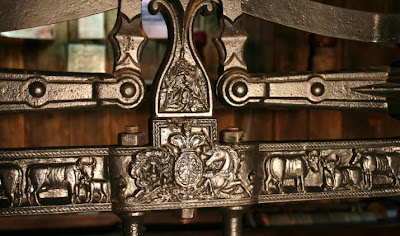Unexpected interest from the blogosphere has transpired overnight for milk testing machinery collected in local museums. It all started with a post written yesterday on this humble blog, regarding a pioneer of the Bega area, Mr. George Guthrey. Impressive detective work by our friends at
Maffra and District Historical Society and
Old Gippstown Heritage Park took inspiration from a set of three babcock milk testers depicted in an image from the original post.
 Three Babcock milk testers in the collection of the Bega Cheese Heritage Centre.
Three Babcock milk testers in the collection of the Bega Cheese Heritage Centre.
So what exactly were the machines testing, and why is it that they came to be taken up as industry standard so soon after the first experiments?
The problem of milk testing is, interestingly enough, a story tied to the unscrupulous behaviour of dairy farmers supplying factories and cooperatives with a tampered milk supply. The guilty farmers had been adding water to the milk to bulk out their daily amount. The action was profitable for farmers as at the time dairy factories were in the practice of paying farmers for the quantity of the milk and not its quality. Those with the expected butter fat content were paid equally to their dishonest peers, per litre. The introduction of the Babcock milk testers, a machine that tested the butter-fat content of milk, helped to standardise the quality of milk accepted at factories. It provided the scientific rigour of testing necessary to impose a floor standard on the acceptable percentage of butter-fat in supplied milk. Unfortunately for some farmers during tough periods, the standards were also a prohibitive rule which caught them off guard when the daily supply was not able to make the grade.

Milk Tester manufactured by the Vermont Farm Machinery Corporation, Bellows Falls, Vermont
The process of testing milk begin with the introduction of a small quantity of amyl alcohol into a glass test bottle. To this liquid was added a small sample of milk through a pipette, delivered into the glass bottle. Strong sulphuric acid was then added, with a wooden cork placed over the neck of the bottle to achieve a firm seal. The contents would then be shaken vigorously until it became a hot solution of a light brown colour. Before placing the glass bottle in the centrifugal machine, a small quantity of diluted sulphuric acid was added. The machine was then worked (in the early days with a hand crank) for about half a minute or until all the contents appeared as a clear yellow oil. The quantity of remaining contents were then read from a scale on the bottle's side.
The test worked on the Babcock principle- that is, that all components of milk other than fat dissolves in sulphuric acid. The centrifugal process allowed for complete separation without having bubbles present in the fat that would likely skew the final result.
 "Official Babcock Tester", in the collection of the Bega Pioneers Museum
"Official Babcock Tester", in the collection of the Bega Pioneers Museum
History of Milk Testing in Australia
Two individuals are believed key drivers in the effort to introduce machines in Australia for testing milk. They are Henry Pateson (associated with the FF&I Co.) and N. Herbert Throsby of the Berrima District Co-operative Company. These two collaborators are connected to the most likely candidate for the title of the first tester having been used in Australia, the Fresh Food and Ice Company, then located in Mittagong.
Other accounts contest the account, acknowledging the role of Mr. Hugh Sinclair, the manager of the Bengelalla factory (located in Shoalhaven) at the time, and crediting him for bringing the Babcock method into use in New South Wales. [Source: A Brief History of Co-operation As Applied to the Dairy Industry, T.C.K, North Coast Daily News Printers, Magellan St., Lismore, circa 1910, p. 16].
From as early as 1879, concern was raised in the NSW government for the declining standards of milk received at factories. In this year the
Adulteration of Food Prevention Act was introduced. From this time until the introduction of the Milk Board in 1931, dairy factories oversaw the testing of milk quality. In 1931, the Milk Board was formed, charged with the responsibility to supervise the quality of milk offered for sale in New South Wales.
The Reaction of Farmers
When milk testing was first introduced, a large majority of farmers were hesitant towards the new standards. Transcripts of interviews conducted for a Royal Commission of Inquiry into food prices and quality revealed the reasons for their distrust. Mr. Harry Lewis Gobble, then manager of the Berrima District Dairy Company, suggested that often the milk of innocent farmers who had not adultered their milk failed the butter-fat standard. He expressed his greivances that farmers who failed the test were being prosecuted, suggesting that only when failed milk was sold should there be any prosecution persued. He says,
I do not think that the public, taking them generally, would pay any more for high quality milk than for low quality milk. It might also lead to endless "fake" on the part of the companies. The public are not educated sufficiently to know whether the milk is 3.2 or 3.8, and they are just as willing to pay for one as for the other as long as it is milk.
This quote was taken from a transcript of an interview conducted on the 13th of March, 1913 at the School of Arts, Robertson. The interviewer was the commissioner, T. R. Bavin, Esq.
For the transcript of the full interview, follow this
link.
For the other interview transcripts, visit the
main page.













































